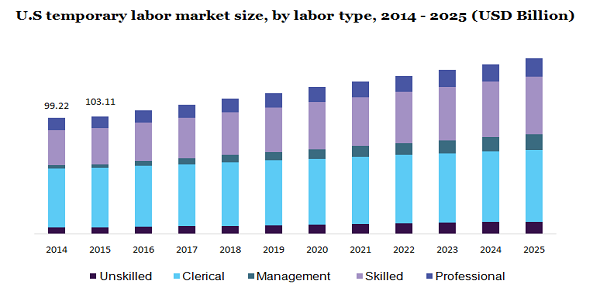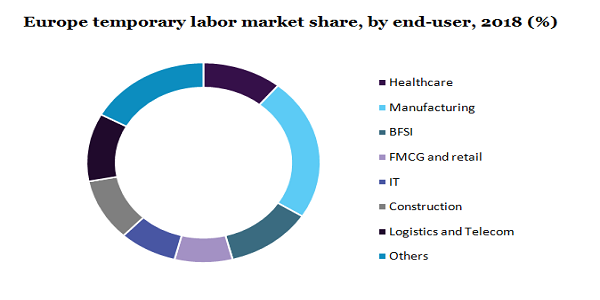- US: +1-408-610-2300
- Toll Free: +1-866-831-4085
- Become a Client
The global temporary labor market size was worth USD 436.42 billion in 2018. The market is estimated to grow at a CAGR of 6.4% over the forecast period, 2019 to 2025. The deployment of temporary labor across various industries such as healthcare, manufacturing, logistics, IT, and others has increased considerably in the recent past. The introduction of various infrastructural products including smart cities by governments is projected to fuel the growth of the market.
Temporary labor offers several benefits including cost reduction in hiring and training. Easy availability of temporary labor means that organizations can deploy them for non-core tasks while deploying their own resources to core tasks. These advantages are estimated to promote market growth.

Organizations often face a shortage of labor, especially during exigencies and peak periods. During such periods, organizations tend to choose the services of temporary laborers. With evolving technologies, the demand for semi-skilled or skilled workers is increasing. Temporary workers can readily bridge this gap.
There are several places where temporary workers can be employed. Often, organizations employ them to maintain their older infrastructure. Retail stores, where footfall increases during festive seasons and public holidays also employ temporary workers to cater to the need and ensure smooth operations of their businesses. Further, these workers are also in demand to cater to the growing need for online delivery services.
However, employing temporary workers, sometimes, affect the productivity of regular employees by instilling a sense of insecurity in them. In addition, temporary workers, engaged in customer services, may pose a challenge and affect customer satisfaction, as customers are more likely to engage with specific sales agents. Thus, these aforementioned factors are anticipated to restrain the market growth.
Based on labor type, the temporary labor market is fragmented into unskilled, skilled, professional, management, and clerical. In 2018, the clerical segment accounted for the largest share in the market with nearly 60%. Incumbents of different industries such as insurance, retail, real estate, and others tend to hire clerical workers for short term for multiple positions such as typists, computer operators, secretaries, receptionists, and office clerks.
Besides that, service-providing and manufacturing companies are hiring managers for a temporary period with an aim to improve the companies’ efficiencies, thereby, spurring the growth of the management segment. To cater to the changing consumers’ requirements, manufacturing companies employ skilled workers for short-terms, thus, augmenting the growth of the labor segment.
The manufacturing sector prefers to hire temporary workers in order to cater to the changing demand during festivals or peak periods. Manufacturing segment incumbents include manufacturers of chemicals, fabricated metals, furniture, and electrical equipment among others. This segment is predicted to dominate the market as manufacturers employ temporary labor to ensure no interruption in their production processes.

The healthcare segment is the other domain, which is estimated to employ temporary labor insignificant number. The growing geriatric population coupled with the increasing number of the disease has led to a rise in demand for trained nurses. These trained nurses are required to provide in-house medical care. With the growing number of diagnostic centers, the demand for temporary medical staff is expected to rise significantly.
In 2018, Europe occupied the largest market share by value and accounted for USD 149.61 billion. The rise in the number of temporary workforce in manufacturing sectors including automobiles is proliferating the growth in the region. Further, the demand for temporary labor is projected to grow with an increasing number of enterprises in Europe.
On the other hand, Asia Pacific is predicted to grow at a steady rate over the next few years. The introduction of several healthcare programs by governments is anticipated to fuel the demand for temporary healthcare workers in the region. For example, the Indian government has introduced different healthcare programs such as Pradhan Mantri Swasthya Suraksha Yojana (PMSSY), National Aids Control Program, and National Vector Borne Disease Control Program (NVBDCP). Such schemes are projected to create the need for temporary laborers, thereby, attributing to the growth of the market.
The temporary labor market has witnessed a mixed response owing to the outbreak of COVID-19. The pandemic has led to the closure of various activities including manufacturing, mining, and construction among others. The social distancing norms and growing focus on curbing the COVID-19 spread have led to labor migration, consequently, affecting the market growth.
However, with the systematic reopening of economies, the demand for temporary labor is rising owing to their easy and cost-effective procurement. The significant drop in the temporary labor requirement has caused unemployment both skilled and unskilled labor, this makes the availability of labor easy.
Major players in the market include Allegis Group, ManpowerGroup Inc., Robert Half International Inc. Westaff, Hays plc, Randstad N.V, Kelly Services, Inc., Persol Holdings Co. Ltd and Adecco. These players are engaged in designing new products and services with an aim to get a competitive edge in the market. For example, ManpowerGroup Inc. launched IntelliReach, which will digitalize management tools.
Further, players are emphasizing mergers and acquisitions to strengthen their dominance in the market. For example, Adecco, in September 2017, acquired Biobridge LLC to expand its base in professional staffing offerings in the field of medical devices, pharmaceuticals, and biotechnology.
|
Attribute |
Details |
|
The base year for estimation |
2018 |
|
Actual estimates/Historical data |
2014 - 2017 |
|
Forecast period |
2019 - 2025 |
|
Market representation |
Revenue in USD Billion & CAGR from 2019 to 2025 |
|
Regional scope |
North America, Europe, Asia Pacific, Central & South America, Middle East & Africa |
|
Country scope |
U.S., Canada, U.K., Germany, China, India, Japan, and Brazil |
|
Report coverage |
Revenue forecast, company share, competitive landscape, and growth factors and trends |
|
15% free customization scope (equivalent to 5 analyst working days) |
If you need specific information, which is not currently within the scope of the report, we will provide it to you as a part of the customization |
This report forecasts revenue growth at global, regional, and country levels, and provides an analysis of the latest industry trends in each of the sub-segments from 2014 to 2025. For the purpose of this study, Million Insights has segmented the global temporary labor market report on the basis of labor type, end-use, and region:
• Type Outlook (Revenue, USD Billion, 2014 - 2025)
• Unskilled
• Clerical
• Management
• Skilled
• Professional
• End-Use Outlook (Revenue, USD Billion, 2014 - 2025)
• Healthcare
• Manufacturing
• BFSI
• FMCG and retail
• IT
• Construction
• Logistics and Telecom
• Others
• Regional Outlook (Revenue, USD Billion, 2014 - 2025)
• North America
• U.S.
• Canada
• Europe
• U.K.
• Germany
• the Asia Pacific
• China
• India
• Japan
• Latin America
• Brazil
• Middle East & Africa (MEA)


Research Support Specialist, USA